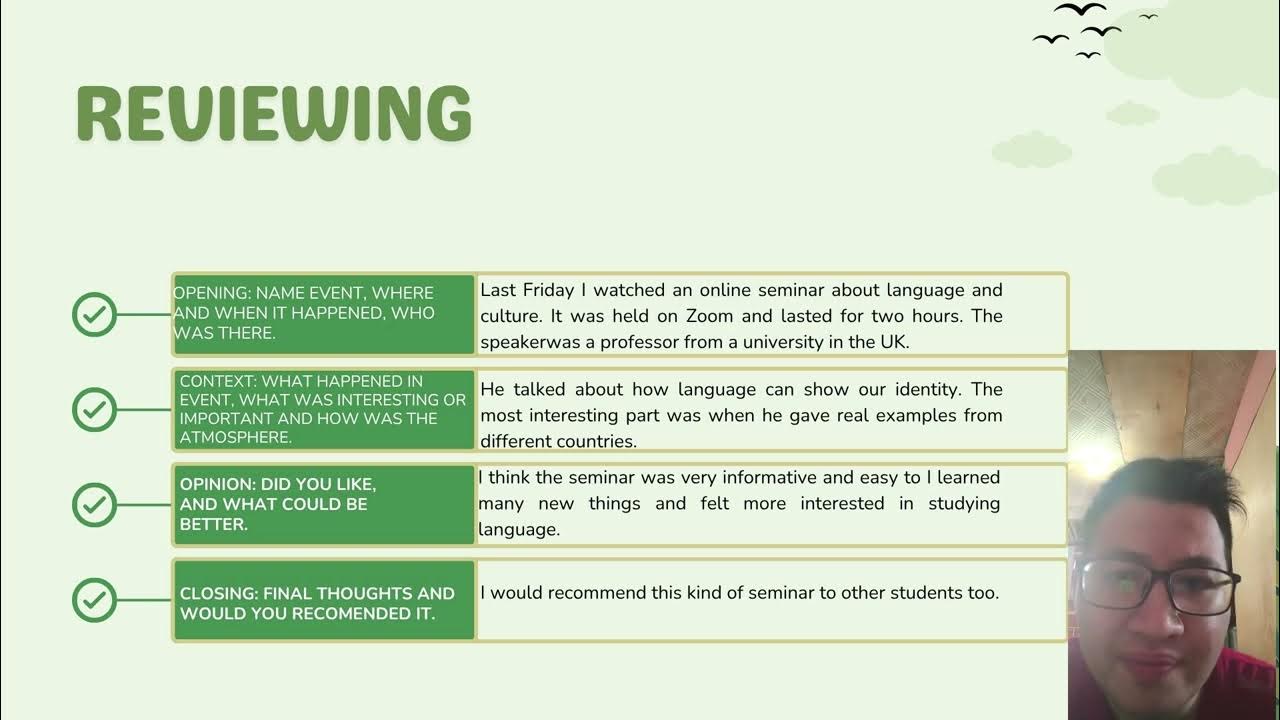4 hal yang perlu diperhatikan pewawancara
Summary
TLDRIn this video, Nur Mubina discusses essential interviewing skills, focusing on attending and reviewing techniques. She emphasizes the importance of maintaining eye contact, being attuned to vocal tone, and being empathetic toward the interviewee. The video also covers how to effectively ask open and closed questions, the role of non-verbal cues, and how to observe emotional conflicts in interviews. These skills help interviewers build rapport, gain deeper insights, and ensure interviews are more effective and insightful. Viewers are encouraged to understand and apply these techniques for better interviewing outcomes.
Takeaways
- 😀 Attending skills are essential for interviewers to conduct effective interviews and ensure understanding between the interviewer and interviewee.
- 😀 Interviewers should be mindful of the balance between asking questions and allowing the interviewee to respond in detail without interruption.
- 😀 Eye contact is crucial for establishing trust and showing confidence during an interview.
- 😀 Vocal tone, speed, and clarity are important for clear communication and understanding during interviews.
- 😀 Interviewers must be sensitive to the emotional state of the interviewee, avoiding questions that could be too intrusive or upsetting.
- 😀 Observing verbal and non-verbal cues, such as body language and facial expressions, helps interviewers gain deeper insights into the interviewee's emotions and thoughts.
- 😀 Authenticity in responses is key—interviewers should be honest and genuine in their reactions and feedback during the interview.
- 😀 Open-ended questions encourage interviewees to share more freely and provide deeper insights into their thoughts and feelings.
- 😀 Closed-ended questions are appropriate for obtaining specific information or confirming details, but should be used sparingly.
- 😀 It is important for interviewers to understand the possible internal conflicts, such as discrepancies between verbal content and non-verbal cues, to better interpret the interviewee's responses.
Q & A
What is the main focus of attending in an interview?
-Attending focuses on actively listening to the interviewee’s responses, understanding when to ask questions and when to remain silent, and observing non-verbal cues such as body language and eye contact.
Why is maintaining eye contact important during an interview?
-Maintaining eye contact is crucial as it demonstrates confidence and helps the interviewer observe the interviewee’s reactions more accurately. It also creates a sense of engagement and trust.
How should an interviewer handle vocal aspects during an interview?
-An interviewer should be mindful of their tone, pitch, and speed of speech. A clear and calm voice helps ensure the interviewee understands the questions and feels comfortable answering.
What should an interviewer be sensitive to when asking questions?
-The interviewer should be sensitive to the emotional state of the interviewee. Questions should not be too invasive or upsetting, especially when the interviewee is not yet ready to open up.
What is the significance of body language in an interview?
-Body language plays a critical role in understanding the interviewee’s emotions and attitudes. Observing gestures, posture, and facial expressions can provide additional insights into their feelings or reactions that may not be expressed verbally.
What is the difference between open and closed questions in an interview?
-Closed questions are those that require short, specific answers (e.g., yes/no), and are often used to confirm details. Open questions encourage the interviewee to provide more elaborate responses, exploring deeper insights and personal perspectives.
Why should closed questions be used sparingly during an interview?
-Closed questions should be used sparingly because they limit the interviewee’s responses and don’t allow for in-depth exploration. They should mainly be used for confirmation or at the end of the interview.
How can open questions improve the interview process?
-Open questions encourage the interviewee to share their thoughts and feelings freely, offering richer insights and making them feel understood and respected. These types of questions also promote a more conversational flow.
What role does observation play in an interview?
-Observation helps the interviewer understand the interviewee beyond their words. It involves analyzing both verbal communication (what is said) and non-verbal cues (such as facial expressions, body posture, and gestures), helping the interviewer interpret the underlying emotions and beliefs.
What are internal conflicts like discrepancies and incongruences, and why should interviewers pay attention to them?
-Internal conflicts, such as discrepancies (differences between what is said and expressed emotionally) and incongruences (differences between expectations and reality), can reveal deeper psychological factors. Recognizing these signals allows interviewers to build a stronger connection with the interviewee and facilitate a more meaningful conversation.
Outlines

This section is available to paid users only. Please upgrade to access this part.
Upgrade NowMindmap

This section is available to paid users only. Please upgrade to access this part.
Upgrade NowKeywords

This section is available to paid users only. Please upgrade to access this part.
Upgrade NowHighlights

This section is available to paid users only. Please upgrade to access this part.
Upgrade NowTranscripts

This section is available to paid users only. Please upgrade to access this part.
Upgrade NowBrowse More Related Video

Name: Moch Surya Saputra_24220078, assignment from study of speaking for profesional context.

Journalism Classes For Young Journalists | The basics of Journalism

Cognitive Prompting(인지적 프롬프팅) 공유회 full ver.

Teknik Umum Konseling 1

The 7 Laws of Film Editing

Girl Power 🔥 Learn driving a Manual Car from Scratch | Girls Car Driving | Day 1
5.0 / 5 (0 votes)